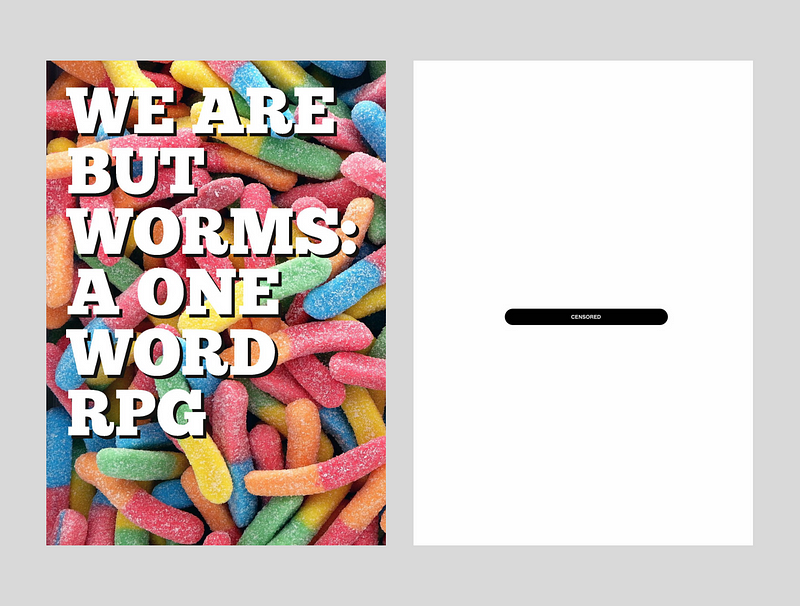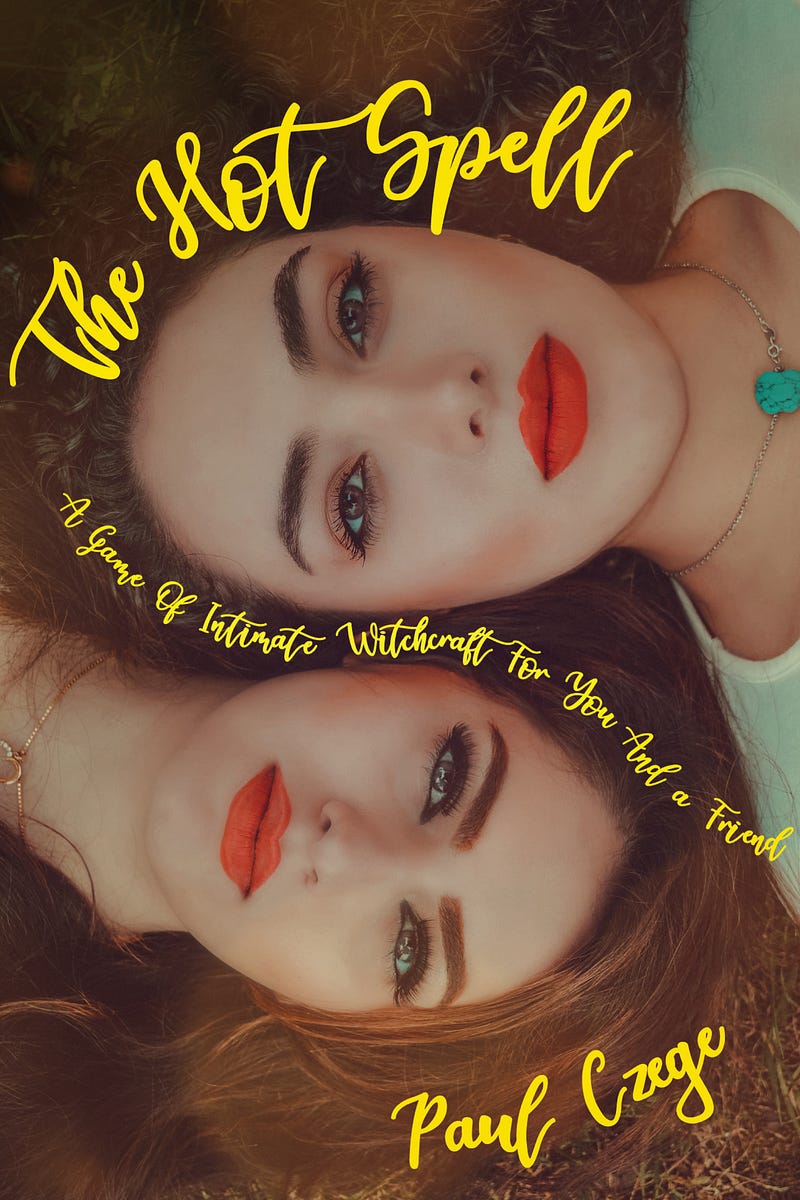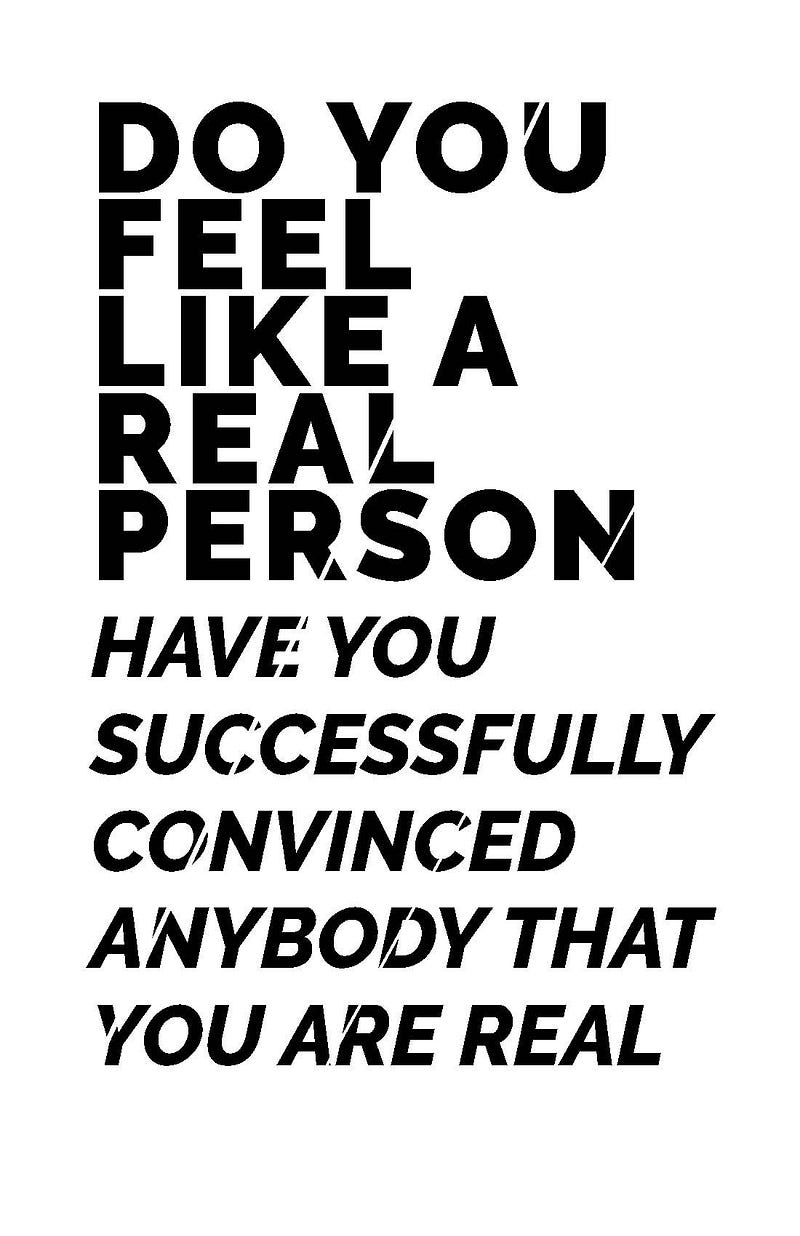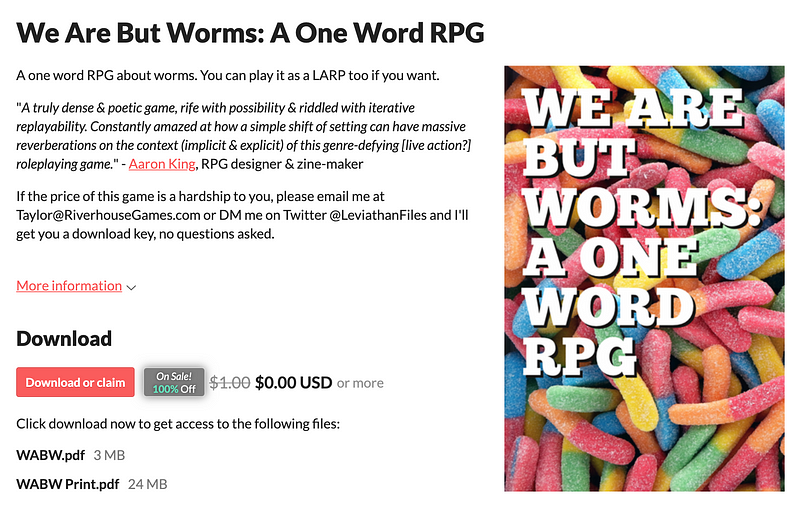On lyric games, ownership, and what makes up a game
We Are But Worms consists of a title and a single-word instruction within a pamphlet format. The sparse rules and undefined ending of the game itself plays with our pre-existing notions of what a game is and the possibilities of what a game could be. By defining an entire game around five words (counting the title, which provides context), creator Taylor LaBresh is expressing a meta-narrative about games and how we bring our experiences, assumptions, and desires to the table. When we as players are faced with a single word that comprises a game, we question how to play at a very basic level. Do we follow instructions? Do we laugh and put the game down? Do we sit and think about whether or not We Are But Worms is a game at all? From the perspective of a lyric game, all these interactions are valid and are part of playing the game itself.
 Left: the
cover of We Are But Worms; a bright mess of Trolli sugar-covered gummi worms in the
background, the title text reads “We Are But Worms: A One-Word RPG”, clearly announcing what you are
getting. Right: The interior page of We Are But Worms, showing a white page with a
single word in the center, but the word has been censored to protect the integrity of the one-word
RPG. Please click here
to support the creator.
Left: the
cover of We Are But Worms; a bright mess of Trolli sugar-covered gummi worms in the
background, the title text reads “We Are But Worms: A One-Word RPG”, clearly announcing what you are
getting. Right: The interior page of We Are But Worms, showing a white page with a
single word in the center, but the word has been censored to protect the integrity of the one-word
RPG. Please click here
to support the creator.Lyric games take traditional formats of role-playing games (RPGs) and expand on what it means to be a player. A tabletop role-playing game (TTRPG) is a game played by moving through a narrative space while embodying a different role according to the rules and structures of the game’s design. Popular TTRPGs include Dungeons and Dragons, Pathfinder, and Vampire the Masquerade.
Lyric games — sometimes called song games, game poems, or simply experimental games — a new kind of narrative tabletop game, have surged in popularity over the past two years. The term was coined by John R. Harness in late 2019, but some games have been back-categorized as lyric; this term was created to describe a larger, contemporary movement. Most people who are interested in these kinds of TTRPGs are both producers and consumers, creating an insular but thriving group of creatives. Lyric games challenge the norms of a traditional tabletop role-playing game by going without the typical markers of a TTRPG. Usually, lyric games employ few rules, minimal dice rolls or statistics, and provide little to no distance between the player and the character within the game. But all those are guidelines — and guidelines, in this genre, are arbitrary.
Lyric games themselves push against the criteria of what constitutes a tabletop role-playing game, both in structure and distribution. More than any metric, the main factor that determines whether or not any game is “lyric” is whether or not the player feels like it is. While a lot of lyric games can be summed up as writing prompts or journal exercises (one of my games, The Bookshelf, falls into this category), many play with basic concepts of gaming and digital ownership.
Gaming with Me, Myself, and I
In most TTRPGs you create a persona that moves within the game, allowing for a divide between in-character and out-of-character actions. You — as an actor — are fundamentally different from your character and what they do. You can make a choice to either improvise or script out your character, giving them personalized characteristics that could vastly differ from your own character and mannerisms.
In lyric games, however, that distance between in-character and out-of-character either does not exist or is very thin. Lyric games often ask you to explore yourself more so than explore a predetermined narrative or structure.
Bad Moon by Adira Slattery is a perfect example. The game is for two players, one of which is the moon. As the non-moon, you are instructed to be pissed off at the moon. The game is a meditation on how there is a problem in your life that is the Moon’s fault, and you both love the Moon and you hate her for what she’s done to you. Bad Moon combines the ritual meditation and surreal exploration of emotions that embody lyric games, centering your experiences as a person, not as a persona.
Lyric games often explore a connection between you and an undefinable force in your life. Sometimes lyric games use metaphor to allow players to imitate distance between personal emotional investments and a game, but many designers recognize that ‘bleed’ — the emotional spillover between a person and a character — can occur even when players are protected by metaphor.
 The cover
of The Hot Spell.
The cover
of The Hot Spell.It is this use of metaphor that allows lyric games to exist. It would be difficult to play a game like Bad Moon and not insert yourself into its rules. Other lyric games like The Hot Spell by Paul Czege and The Mermaid Spell by Jamila R. Nedjadi are about ritual. They both create a way for you, as a person, to inhabit a space within the instructions and allow for your own experiences to fill in the gaps. The Hot Spell is about intimacy and witchcraft, but it is specifically about creating a scenario where you feel hot, turned on, or intimate with another person. By allowing space for bleed within the narrative framework of the game, The Hot Spell can only be played when the player destroys the barrier between person and persona. Likewise, The Mermaid Spell is a guided meditation on pain, heartbreak, and grief that requires deep introspection. Both Czege and Nedjadi write warnings into their games that they have the potential to harm the player because of the possibility for bleed, firmly rooting both of these lyric games in personal experience. By doing so, games like Bad Moon, The Hot Spell, and The Mermaid Spell become nonfiction pieces that encourage people to insert their own experiences into their framework. A game created around metaphor is still an immediate experience and works to reflect the life of the player at the table, denying that player distance between who they are and how they interact with the game.
Other games that ask you to be the character include the moon, the crow by Blake Stone; Kienna Shaw’s Your Magic Circle, and rpgNatalie’s The Breaking of Curses.
Roleplaying with roleplaying
Lyric games are not for playing but, rather, for recontextualizing common experiences in order to challenge the game-playing process. A Game About Throwing Tantrums (published by Possum Creek Games but written by an anonymous author, identified as “an ex-problem child”) allows the player to go through the experience of throwing a tantrum by laying out rules and distinct steps for employing reactions. The player starts by picking someone to disagree with and uses dice to find the source of their disagreement. Examples of these combinations include: “You are speaking to a parent,” and “you fail a task,” and “you are speaking to a girl who is friends with other girls,” and “you are accused of something.”
 The
second-to-last page of Tantrums.
The
second-to-last page of Tantrums.Tantrums takes you through different scenarios and asks you to roll to choose your reaction. If you are accused of something, you roll to find out if you argue, attempt to dominate, or self-victimize, but within those actions you are allowed to choose the exact nature of that reaction. For example, you can self-victimize by crying, hunching your shoulders, saying “please,” and gaining the sympathy of onlookers. By breaking down some of the ways we react to situations, Tantrums shows how the literal act of throwing a temper tantrum is both involuntary (rolling a dice) and calculated (picking a secondary reaction). Tantrums takes a familiar experience and forces the player to reinhabit that experience from a different perspective, creating a game that allows for a re-imagining of personal experiences. This game in particular is cyclical, and, much like the stages of a temper tantrum repeat themselves, this game makes you repeat actions, sit with your feelings, and return tomorrow to inhabit the experience again, structurally enforcing the idea of lyric games acting as a method of re-evaluating your experiences.
Another lyric game that asks players to recontextualize experiences is Legendary Vermin’s Until Next Time, a game about smoking, for smokers. The game asks you to gather a group of smokers and take out a full pack of cigarettes. As you smoke the pack, you answer questions such as, “Who was the coolest person you smoked with,” “Tell us about a time where smoking made you feel accepted,” and “What’s the weirdest idea you’ve ever had while smoking?” When you reach the last cigarette in the pack, each player has to answer the question, “When was the last time you tried to quit smoking?” After that cig is done, you exchange contact information. The final instruction is that the next time any of the players lights up, they have to contact the entire group with the phrase “We lost.”
A game like Until Next Time does not necessarily end when you step away from the game because the rules say that losing the game is predicated on the actions — or inactions — of the players in their lives outside of the game. The rules never define a win condition. You either smoke your last cigarette while playing the game, or you lose the game. By re-imaging the experience of smoking as a game, Until Next Time inhabits an action within your life, creating a new experience of play and adding new conditions to the act of smoking that you take into your life even after the game, regardless of whether or not you follow those directions.
Other examples of lyric games that ask players to inhabit their own experiences through a different lens include Adam Vass’ Diagnostics, Natalie Libre’s Instructions for Solving Mathematical Problems, Jay Dragon’s Almost, and Making Love, by Adira Slattery.
Reading between the lines
Most of the people who enjoy lyric games also create lyric games, so there tends to be a lot of self-referential playfulness. Maria Mison’s I EAT MANTRAS FOR BREAKFAST uses formatting, layout, and other commonly understood conventions with aesthetic, gamified flair. Using all-capitals throughout the layout, IAMFB imitates a voice yelling. It’s never said in the text that this game is shouting at you, but it is. This game specifically uses textural media rules already in your head to create a piece of gameplay. This is much like We Are But Worms, which encourages a personal interpretation of the text because of the way the text exists on the page.
Lyric games delight in providing a guided experience through these liminal moments, where players are both active participants in the game and left wondering whether or not they’re playing the game correctly. A game like Game Lamprey, by Richard Kelly, has a set of rules deliberately designed to provoke. You play Game Lamprey by playing a different game and then “attaching” the rules within Game Lamprey to that second game in the midst of gameplay. One of the rules of Game Lamprey is that you can choose to automatically succeed within the second game, but you have to rip out a page from that game’s rulebook — an action that weakens the game you are attempting to play, and goes very deliberately against the commonly accepted behaviors associated with owning a game. Lamprey asks that you break other rules in order to play it.
When we look at games like this, which reflect on the nature of what a game is, and whether or not it’s even possible to play these games, we realize that lyric games are experiments in pushing the boundaries of guided, immersive experiences. Lyric games take rules that we accept within our day-to-day lives and comment on them within the framework that players have opted into and have the power to accept or deny. Lyric games only really become a game when we interact with them. Until the player picks up a game, it is merely a scaffolding around the unknowable marble of player experience. We have to sculpt the statue.
Lyric games take advantage of this liminality of incompleteness. If even reading a game becomes the act of interaction with the game and its rules, the lines in between audience and author, owner and recipient, begin to blur. Do you play your game as you write it? Do you experience the act of creation, or do you just keep tweaking your game until something comes out that’s as close to complete as any game can be without a player at the table?
Other games that play with these implied rules within their layout or distribution include there is no such place as an empty field by Blake Stone, The Magus by momatoes, and the $100 game by Justin Joyce, Just Tryna Pay Rent.



 A series of
four screenshots from the game I EAT MANTRAS FOR BREAKFAST, showing bright colors,
bold text, and “screaming.” The text is self-referential and creates a strange energy on the page.
When you read the third slide, there is a moment of confusion where you read, “This moment is
inevitable I am inevitable” and the text is a self-fulfilling prophecy of engagement.
A series of
four screenshots from the game I EAT MANTRAS FOR BREAKFAST, showing bright colors,
bold text, and “screaming.” The text is self-referential and creates a strange energy on the page.
When you read the third slide, there is a moment of confusion where you read, “This moment is
inevitable I am inevitable” and the text is a self-fulfilling prophecy of engagement.
You get a game! You get a game!! YOU!! GET A GAME!!!
Finally, one of the structural markers of a lyric game is less about the game itself and more about how that game is distributed and thought about by the people who download and play these games. Indie game creators have developed a highly accessible model of distribution that supports the ethos of unownable games. Often lyric games are short, require a low bar of entry to play and understand, and are free or inexpensive.
Indie, in the game world, means that the creator of the game is the one putting the game up for sale and receiving a majority of the profit. The indie community primarily distributes their games using the open marketplace itch.io, a site primarily geared towards small video game studios.
The indie game community uses itch.io as the marketplace for distribution for a variety of reasons, but most notably is, in my opinion, the ability to accommodate “community copies” — free copies of games, usually reserved for marginalized groups or those for whom price is a burden. Community copies are a construct of the indie game scene on the itch.io system and are not an intended feature of the marketplace. The ability to allow creators to list a limited number of free items alongside purchasable items was originally meant for “demo” versions of video games, not necessarily free games. After a few key players in the indie game scene began instituting this social contract based on an honor system, the community as a whole made the shift towards providing free copies. Now, most games (with only some exceptions, typically larger games or games with multiple contributors) have community copies available, either at an unlimited amount of “paid” for via each at-price purchase of the game.
There are other ways that creators play with the idea of purchasing a game. There are games that are available for a price but discounted 100%, resulting in a no-cost game. (We Are But Worms, at the time of this article, appears this way.) There are games where the suggested price is a pun, such as in Instructions for Solving Mathematical Problems, and the game is explicitly free, despite the price of $61.74 showing up when you go to download the game.

 The landing
page for We Are But Worms, which gives instructions for anyone burdened by price to
reach out to Riverhouse Games for a gratis copy. Further down, the price is listed as ‘$1.00’ but
crossed out. Next to it is a note that this game is “On Sale! 100% off.” The landing page for
Instructions for Solving Mathematical Problems reminds the
audience that the suggested game price is “a math joke,” and all purchases will be refunded.
The landing
page for We Are But Worms, which gives instructions for anyone burdened by price to
reach out to Riverhouse Games for a gratis copy. Further down, the price is listed as ‘$1.00’ but
crossed out. Next to it is a note that this game is “On Sale! 100% off.” The landing page for
Instructions for Solving Mathematical Problems reminds the
audience that the suggested game price is “a math joke,” and all purchases will be refunded.
These distribution mechanisms are just one way that the concept of lyric games opposes the notion of capital ownership. Many creators of lyric games would love to see their hobby turn into a full-time job, but they want to be valued and paid for their artistry, not the object they produce. But more fundamentally, because of the nature of playing a lyric game, you cannot own a lyric game. You may read them, experience them, and then move on. You might print the instructions to carry with you. But do you own that game? No. You merely carry it with you for a few moments or even a few hours, and then it passes from you. It is an experience, not a thing you own.
Lyric games challenge what it means to create, own, and share art in a world that is slowly becoming more obsessed with ownership in digital spaces. By creating a holistic experience outside of the rules of traditional RPGs, from purchase to play, lyric games are blurring the lines between audience and author.
For a community response to Lyric Games, you can start here.
Yes, that’s a game too.
For more news, discourse, and resources on immersive and emerging forms of nonfiction media, sign up for our monthly newsletter.
Immerse is an initiative of the MIT Open DocLab and receives funding from Just Films | Ford Foundation and the MacArthur Foundation. The Gotham Film & Media Institute is our fiscal sponsor. Learn more here. We are committed to exploring and showcasing emerging nonfiction projects that push the boundaries of media and tackle issues of social justice — and rely on friends like you to sustain ourselves and grow. Join us by making a gift today.